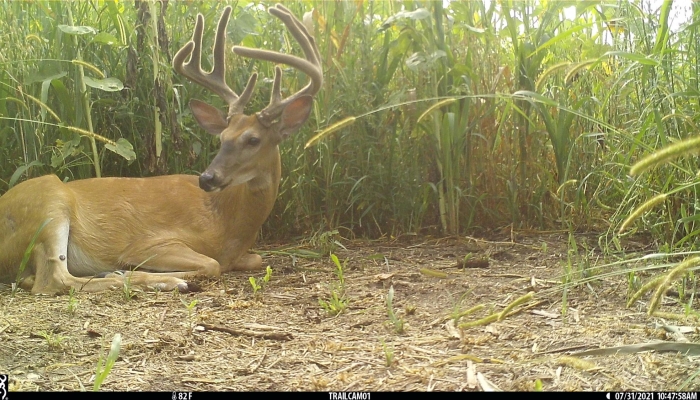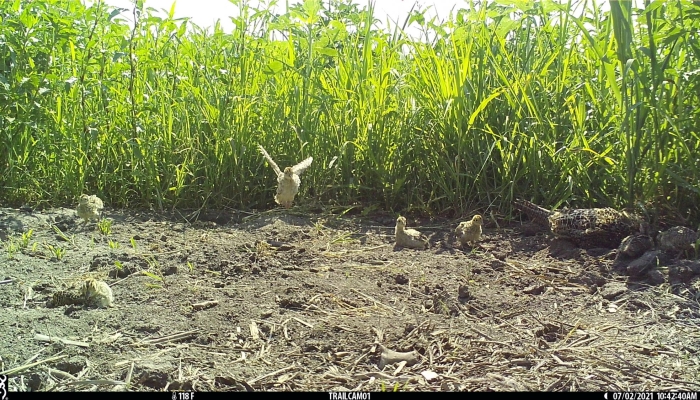Habitat Happenings: Wildlife Habitat on Row Crop Acres
Written By: Nathan Pflueger – Pheasants Forever Precision Ag Coordinator
Did you know Pheasants Forever is working with producers across the eastern portion of the Rainwater Basin to benefit row crop operations and local wildlife? As you travel throughout the basins it is no secret that row crop acres are a substantial part of the landscape. This area has highly productive soils, a conducive climate for row crop production, and the potential for reliable irrigation.
Since the Basins are dominated by row crop agriculture, Pheasants Forever looked for ways to incorporate wildlife habitat into existing row crop acres and cover crops were identified as a perfect fit. Historically, a cover crop was a crop grown between cash crops with the sole purpose of keeping the soil covered. Today, cover crops are used for a wide variety of soil health purposes (i.e., erosion control, nutrient management, forage production, etc.), but they can simultaneously create habitat for local wildlife in certain scenarios. Within the Rainwater Basin Complex, we see most of the landscapes structure removed after corn and soybeans are harvested in the fall. This puts an even bigger burden on local pockets of perennial habitat because they are now the only useable structure for game birds on the landscape. To help combat this problem Pheasants Forever and Quail forever of Nebraska in partnership with The Natural Resource Conservation Service, The Nebraska Game and Parks, and The Nebraska Environmental Trust created the Pathway for Wildlife Precision Ag Conservation Program.
Through the Pathway for Precision Ag Conservation Program, Pheasants Forever works with producers to plant cover crops on row crop acres in a wide variety of scenarios. The Full Season Cover Crop Practice creates useable structure for upland game birds that supplements preexisting perennial habitat through the fall and winter months when row crops are no longer standing. The practice requires a producer to have productive row crop acres within two miles of existing quality perennial habitat. A producer must also agree to plant a diverse cover crop mixture on the row crop acres prior to June 1st and then leave the biomass standing until March 15th of the following year. Once contract obligations are met the producer is eligible to receive a $300 per acre foregone income payment along with 75% cost share on the cover crop seed. Post March 15th the producer can utilize the biomass however they prefer and can again row crop the previously enrolled acres.
To ensure this new practice is being used by upland game birds and other wildlife we have implemented monitoring techniques including camera traps and small mammal trapping. Volunteers from the Nebraska Master Naturalist Foundation have helped gather thousands of photos of pheasants, quail, and numerous other wildlife species within our plots throughout the summer, fall, and winter months. It should also be noted that we have photos of hen pheasants with their broods within the cover crop plots. Small mammal trapping is used to compare small mammal species diversity, relative density, and species richness between our cover crop site and the adjacent row crop acres. Even though our data set is small it does suggest that species diversity, relative density, and species richness tend to be higher on the cover crop acres. As we continue to learn and work with producers to evolve the program our goal is to have producer, soil health, and wildlife wellbeing in mind. For more information on the Pathway for Precision Ag Conservation Program, contact Nathan Pflueger, Pheasants Forever Precision Ag Coordinator at npflueger@pheasantsforever.org.
You can also access cover crop cost-share and additional resources through the Upper Big Blue Natural Resources District. Contact Dan Leininger, NRD water conservationist, to get started. Call 402-362-6601 or email Dan at dleininger@upperbigblue.org.
Did you know Pheasants Forever is working with producers across the eastern portion of the Rainwater Basin to benefit row crop operations and local wildlife? As you travel throughout the basins it is no secret that row crop acres are a substantial part of the landscape. This area has highly productive soils, a conducive climate for row crop production, and the potential for reliable irrigation.
Since the Basins are dominated by row crop agriculture, Pheasants Forever looked for ways to incorporate wildlife habitat into existing row crop acres and cover crops were identified as a perfect fit. Historically, a cover crop was a crop grown between cash crops with the sole purpose of keeping the soil covered. Today, cover crops are used for a wide variety of soil health purposes (i.e., erosion control, nutrient management, forage production, etc.), but they can simultaneously create habitat for local wildlife in certain scenarios. Within the Rainwater Basin Complex, we see most of the landscapes structure removed after corn and soybeans are harvested in the fall. This puts an even bigger burden on local pockets of perennial habitat because they are now the only useable structure for game birds on the landscape. To help combat this problem Pheasants Forever and Quail forever of Nebraska in partnership with The Natural Resource Conservation Service, The Nebraska Game and Parks, and The Nebraska Environmental Trust created the Pathway for Wildlife Precision Ag Conservation Program.
Through the Pathway for Precision Ag Conservation Program, Pheasants Forever works with producers to plant cover crops on row crop acres in a wide variety of scenarios. The Full Season Cover Crop Practice creates useable structure for upland game birds that supplements preexisting perennial habitat through the fall and winter months when row crops are no longer standing. The practice requires a producer to have productive row crop acres within two miles of existing quality perennial habitat. A producer must also agree to plant a diverse cover crop mixture on the row crop acres prior to June 1st and then leave the biomass standing until March 15th of the following year. Once contract obligations are met the producer is eligible to receive a $300 per acre foregone income payment along with 75% cost share on the cover crop seed. Post March 15th the producer can utilize the biomass however they prefer and can again row crop the previously enrolled acres.
To ensure this new practice is being used by upland game birds and other wildlife we have implemented monitoring techniques including camera traps and small mammal trapping. Volunteers from the Nebraska Master Naturalist Foundation have helped gather thousands of photos of pheasants, quail, and numerous other wildlife species within our plots throughout the summer, fall, and winter months. It should also be noted that we have photos of hen pheasants with their broods within the cover crop plots. Small mammal trapping is used to compare small mammal species diversity, relative density, and species richness between our cover crop site and the adjacent row crop acres. Even though our data set is small it does suggest that species diversity, relative density, and species richness tend to be higher on the cover crop acres. As we continue to learn and work with producers to evolve the program our goal is to have producer, soil health, and wildlife wellbeing in mind. For more information on the Pathway for Precision Ag Conservation Program, contact Nathan Pflueger, Pheasants Forever Precision Ag Coordinator at npflueger@pheasantsforever.org.
You can also access cover crop cost-share and additional resources through the Upper Big Blue Natural Resources District. Contact Dan Leininger, NRD water conservationist, to get started. Call 402-362-6601 or email Dan at dleininger@upperbigblue.org.


